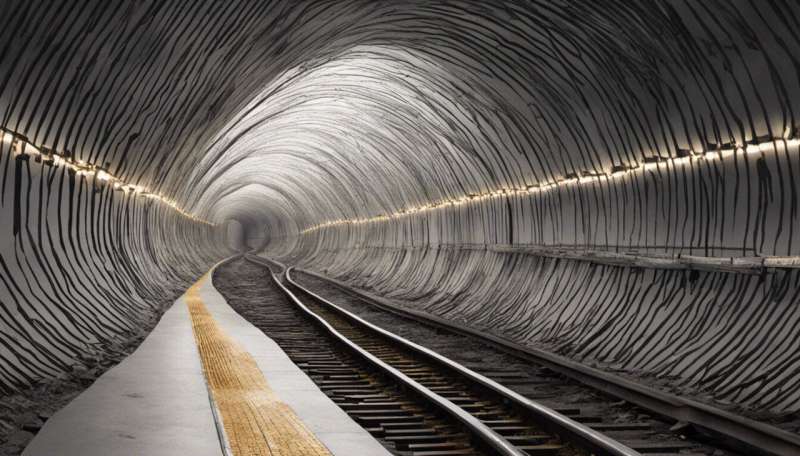Tunnel fire safety: With only minutes to respond, fire education really counts

Global risk management experts are calling for fire education initiatives to be included in driver safety programs so that drivers are better prepared for an emergency if faced with it on the roads.
The call follows a new research study where researchers from University of South Australia and the National Technical University of Athens assessed fire safety mechanisms of road tunnels, finding that risks to human life could be reduced through greater awareness and education.
Using a newly developed evacuation model, researchers were able to simulate the behaviors of trapped-commuters and their movement to estimate potential outcomes and fatalities following a fire in a road tunnel.
UniSA Adjunct Associate Professor Konstantinos Kirytopoulos says being able to forecast human behavior in a fire-risk scenario provides critical information for safety analysts and tunnel managers.
"To mitigate potential fire accidents and disastrous consequences in road tunnels, safety analysts not only have to fulfill standard regulatory requirements, but also need to conduct a complex risk assessment which includes defining the issues, identifying hazards, calculating and prioritizing risks, and doing so for different environments," Assoc Prof Kirytopoulos says.
"An evacuation simulation model such as ours is particularly valuable because it lets analysts thoroughly inspect all parameters within an emergency.
"Uniquely, it also simulates human behavior and movement in conjunction with the use of safety mechanisms, letting us project the likelihood of successful evacuations under different combinations of human behavior, safety procedures implementation and safety infrastructure employed, which provide an extremely useful tool for tunnel safety analysts.
"Safety levels are dictated by the operation of the whole system—organization, technical and human elements—so anything we can do to increase the success rates of these individual factors can have a massive impact on the whole.
"Having a familiarity with emergency protocols in a confined or enclosed space such as a road tunnel can help trapped-commuters to appropriately respond, and this, we believe will improve successful evacuations."
Road tunnels are fundamental elements of road transport systems contributing to profitable economies and societies. Given the sheer number of vehicles on the road—about 262 million passenger cars in the European Union; more than 272 million vehicles in the United States; and an estimated 19 million vehicles in Australia—safety is paramount.
Fire accidents in tunnels can have disastrous consequences in terms of human loses and structural damage. Although tunnel safety has increased significantly since previous fire tunnel tragedies such as the Mont Blanc Tunnel fire (France,1999 with 39 fatalities), Fréjus tunnel fire (France, 2005 with 2 fatalities and 21 injuries) and Yanhou Tunnel fire (China, 2014 with 40 fatalities), these incidences highlight the severity of potential impacts and provide insights for mitigating future risks.
Assoc Prof Kirytopoulos says commuters are the most variable factor in the event of a tunnel fire because they're the first to confront the consequences of the fire and in most cases are inadequately trained for such circumstances.
"When the tunnel operator calls for an emergency evacuation through public address systems, radio rebroadcast or electronic tunnel message signs, people should respond immediately and evacuate, without any delay," Assoc Prof Kirytopoulos says.
"Fires are very complex phenomena, and when in an enclosed tunnel environment, they're characterized by turbulence, combustion irregularity and high radiation. Tunnels fires are also known to have an incredibly intense heat release rate—even four times the intensity of fires in an open environment—as well as large amounts of toxic fumes and smoke.
"In an emergency, time is crucial. The evacuation of the tunnel should be as quick and efficient as the evacuation of an airplane after crash landing. Educating drivers on what they should do as well as making them aware of the evacuation systems which are in place are the best means for mitigating risk and ensuring a safe outcome."
Top 10 longest tunnels around the world:
- The 24.51 kms Lærdal Tunnel in Norway is one of Norway's 1000 tunnels and is the longest road tunnel in the world
- The 18.2 kms Yamate Tunnel in Japan lies 30 meters below the surface, and is the longest road tunnel in Japan.
- The 18.04 kms Zhongnanshan Tunnel in China is also the world's longest twin-tube tunnel
- The twin-tube 17.54 kms Jinpingshan Tunnel in China is located between sites of Jinping-Iand Jinping-II Hydropower Station
- The 16.91 kms St. Gotthard Road Tunnel in Switzerland took ten years to complete and carries 17,000 vehicles per day.
- The 14.4 kms Ryfylke tunnel in Norway is the longest and deepest subsea road tunnel in the world, with its deepest point 292m below sea level.
- The 14.34kms Mount Ovit Tunnel in Turkey was first conceived in 1880 as part of the Ottoman Empire. Construction started in 1930 and it opened in 2018.
- The 13.97 kms Arlberg Road Tunnel in Austria has eight escape routes and is monitored continuously through more than 40 video cameras.
- The 13.65 km Xishan Tunnel in Shanxi Province, China is a major part of S56 Taigu Expressway in Taigu City, Shanxi Province
- The twin tube Hongtiguan Tunnel in Shanxi is 13.12 kms long and part of the S76 Shanxi Changzhi-Pingshun Expressway.
In Australia, the longest road tunnels reach no more than 7 kilometers in distance, with Australia's longest tunnel being the 6.7 km Airport Link Tunnel in Brisbane.
More information: Panagiotis Ntzeremes et al. Quantitative Risk Assessment of Road Tunnel Fire Safety: Improved Evacuation Simulation Model, ASCE-ASME Journal of Risk and Uncertainty in Engineering Systems, Part A: Civil Engineering (2019). DOI: 10.1061/AJRUA6.0001029


















